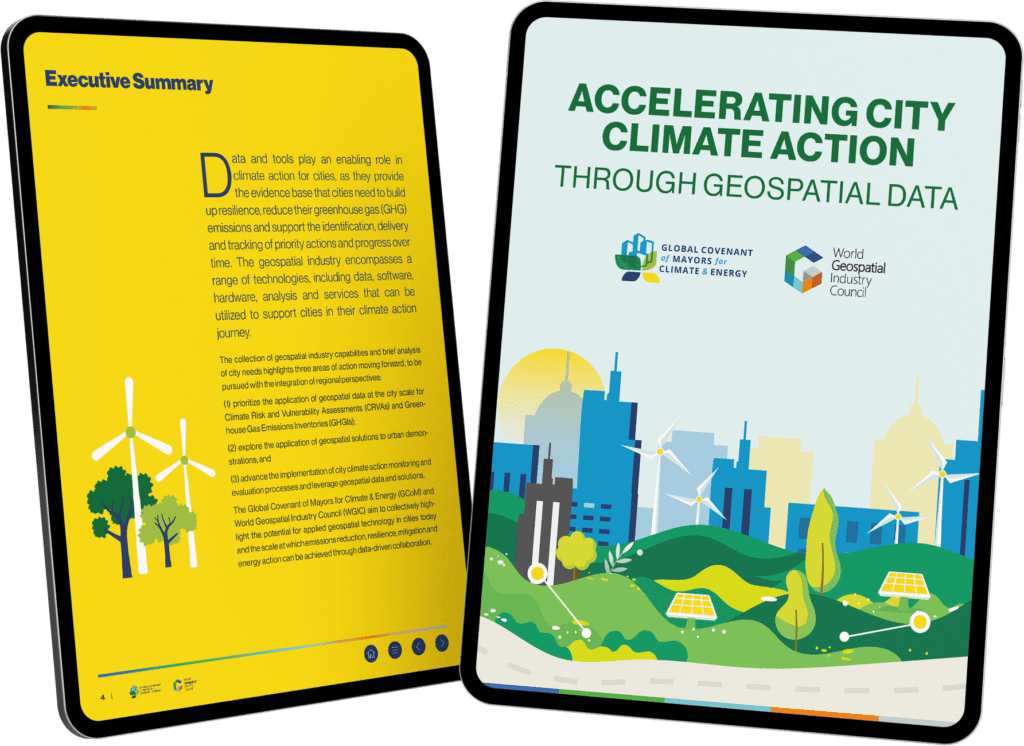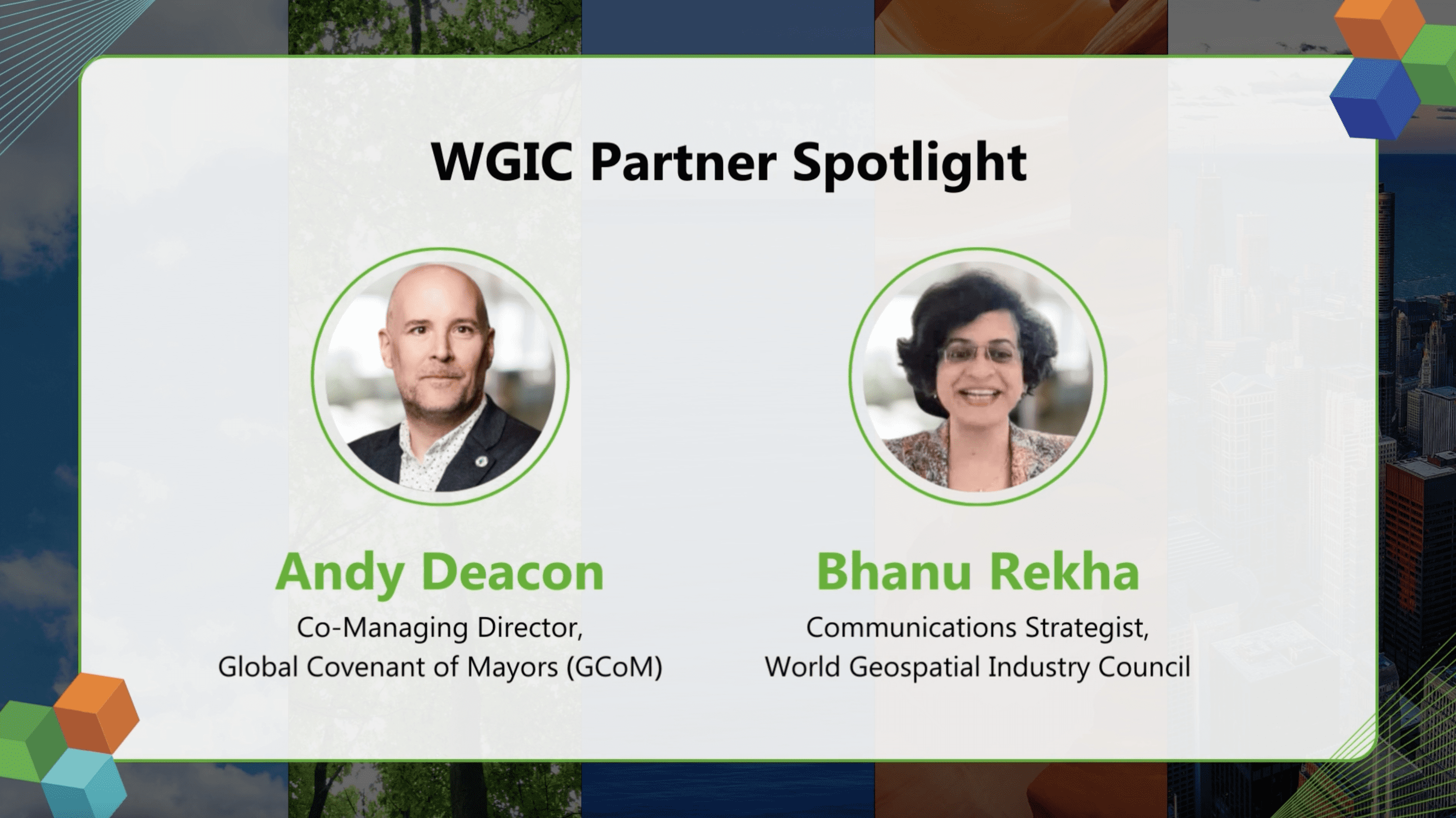WGIC: Andy Deacon, thank you so much for this conversation. Your insights are invaluable to both WGIC members and the wider geospatial community. Can you tell us about the Global Covenant of Mayors for Climate and Energy (GCoM)? What’s the essence of its charter, and how does it live its mission?
Deacon: Thank you and all the WGIC members.
GCoM is the world’s largest alliance of cities, taking action on climate change. It has more than 13,000 signatories and cities spread across the globe, each of whom has committed to taking action. That’s at least as ambitious as their respective national governments, and more than 70% of them have committed to going further to a deeper level of emissions reduction, and around half of them committed to delivering that level of emissions reduction faster than their national governments. We are seeing a large group of subnational city actors willing and making concrete commitments to move faster than their national governments.
All of those commitments are supported by information gathering on emissions inventories, and for more than 7,000 of those cities, climate action plans are in place, and others are working to develop them.
We see our role as being the global umbrella organization to support our networks of 13 regional and national Covenants of Mayors who are providing support to those cities in both preparing those action plans and in advancing projects for investment and implementation, all toward the overarching goals of helping to deliver the Paris Agreement on climate change.
WGIC: It is inspiring to see that level of commitment among cities. Diving deeper into GCoM’s activities, are there any recent initiatives or programs helping to advance these objectives?
Deacon: We have a set of key initiatives that support the delivery of our strategic goals, which are to continue growing our alliance, deepen support for committed cities, and accelerate action across all levels of government and society.
For example, one key initiative is Invest for Cities, which focuses on finance and investment, aiming to mobilize technical assistance and support to build a pipeline of investment-ready projects and establish connections to various sources of finance for investment and implementation.
Another initiative, Data for Cities, focuses on data and reporting. In 2023, we added clean energy access and energy poverty as a third pillar of the Global Covenant action. We aim to understand better access to clean energy and the impacts of energy poverty across our vast network of cities.
The final initiative I will mention for now is Innovate for Cities, which aims to identify the role of research and innovation in addressing gaps in cities’ understanding and helping them progress along their climate action journey.
WGIC: Would you like to share some examples of how these programs and initiatives bring tangible benefits to cities and enable them to further their climate action efforts?
Deacon: Yes, of course. Recently, we collaborated on a publication with WGIC about the value of geospatial data and technologies for cities. For instance, one example highlighted in this white paper is the city of Riga in Latvia, which utilizes remote sensing data and low-cost ground-based sensor technology to enhance awareness and understanding of air pollution levels within the city. This helps with action planning for climate and clean air initiatives, ultimately improving the quality of life for residents.
We have also seen similar efforts in parts of Latin America, focusing on enhancing risk and resilience at the city level, particularly in climate adaptation and the integration of nature into urban environments. Some cities have implemented large-scale urban reforestation or tree-planting programs supported by ground-based and remotely sensed information regarding temperature, shading, and tree cover.
WGIC: Are cities taking action based on these reports, datasets, and solutions and making tangible progress in their climate action efforts?
Deacon: For example, in our annual exercise, we consistently find that the most frequently reported hazards in cities relate to overheating, including exposure to heat waves and extreme temperatures. We gather this information from as many GCoM signatory cities as possible.
This issue has rapidly gained prominence over the past few annual weather cycles. Ten pioneer cities have come forward through the Cool Coalition, supported by the UN Environment Programme, to appoint Chief Heat Officers and develop heat action plans.
The role of geospatial data in understanding heat distribution patterns within cities is crucial for informing citizens and preparing action plans to protect and improve public health.
WGIC: It is commendable how cities are taking action, which brings me to my next question. Andy, drawing from your rich experience working with GCoM, as well as previous roles with Future Climate and other organizations, along with your interactions with city administrations and mayors worldwide, what do you see as the top three challenges for cities in climate action and how is GCoM enabling cities to overcome these challenges?
Deacon: If I asked some of our mayors, they would answer ‘finance, finance, finance’ for all three. I would definitely say that finance and investment have been particularly important to turn action plans into reality. We have a global partnership with the World Bank and European Investment Bank (EIB) through the City Climate Finance Gap Fund, providing feasibility support to help translate city climate action plans into projects for investment. Several hundred projects have entered a pipeline to receive support from that facility. Still, we need many more, especially early-stage feasibility support, to move projects toward investment.
Data for risk assessment is also crucial. I have previously been engaged at the central government level in the UK and involved in climate risk assessment. This led to setting out risk and vulnerability information to aid decision-making at central and local government levels.
Mayors are increasingly seen as first responders after climate disasters due to their role in communicating with the public, often through various media channels. Better predicting and preparing for these events is vital to protect infrastructure and population.
Finally, technical assistance mobilization with sectoral understanding, such as waste management or transportation patterns within cities, is crucial. Geospatial data plays a significant role in understanding these aspects and can contribute to addressing emissions mitigation and urban planning challenges.
WGIC: It seems we are on the same page here. How do you perceive the overall awareness among cities, particularly within the GCoM membership, regarding the role of technology? Considering that technology is crucial in providing solutions through data and information, it would be interesting to gauge the general sentiment.
Deacon: I think it varies enormously depending on the region. For example, our most significant growth in recent years has been in South Asia, Southeast Asia, and Latin America, where we are dealing with a large cohort of rapidly urbanizing secondary and tertiary cities. In these contexts, engaging with urban land use planning systems and incorporating an understanding of climate evolution and risk assessment for future challenges like flooding, overheating, and increased storminess is crucial.
Urban leaders, particularly those at the forefront, are embedding this understanding within their climate action planning. Cities are exploring innovative finance mechanisms, such as green municipal bonds, and engaging with the insurance industry to insure their assets and those of their residents. There is a growing sophistication in aligning climate change considerations with other municipal processes, with a notable interest in climate budgeting to integrate financial decision-making with climate action.
Solid data is essential for making these assessments and building linkages, particularly for municipal authorities as they move forward with their initiatives.
WGIC: Thank you for the insights. Let’s now delve into GCoM’s association with WGIC, the World Geospatial Industry Council. What prompted GCoM to collaborate with WGIC, and how has your experience over the past year and a half of this successful partnership been?
Deacon: GCoM has a robust program focused on research and innovation, mainly through the Innovate for Cities initiative. About two and a half years ago, we conducted research to produce a white paper on tools and data supporting city decision-making, which you can find on www.globalcovenantofmayors.org. From that work, we recognized the need to provide more data to support cities in realizing their climate action plans. This led to discussions at geospatial industry conferences and events around 18 months to two years ago and engagement within the UN climate process, including international climate events like the COPs (Conference of the Parties).
It became apparent that there were two communities — cities in the Global Covenant of Mayors and the geospatial industry — with valuable information and understanding that were not always effectively connected. Part of the Global Covenant’s role is to bridge those gaps and build understanding across a large cohort of cities and globally relevant supporting organizations, of which WGIC is one.
WGIC: Is this the context that prompted GCoM to initiate a joint white paper you mentioned earlier? How do you perceive the response from city stakeholders to the knowledge presented in this paper?
Deacon: It was fantastic to launch our white paper at the UN Environment Assembly in Nairobi just a few months ago, alongside the Citizen Region summit. We had prominent local leaders, UN decisionmakers, representatives from national governments, and others in attendance. The response was overwhelmingly positive right from the start, with a sense that the time has come to bring these communities closer together. There’s a growing recognition of the vast volume of data and information available, although it’s not always easily accessible to local leaders. Some of it is freely available, while some require payment, but there’s a consensus on the value of this data and its role in enhancing local decision-making processes.
The importance of this issue is becoming increasingly apparent, especially as local leaders are required to justify budget decisions and anticipate future risks and hazards within their cities. These communities undoubtedly need to come together through initiatives like this to develop solutions and drive more robust decision-making at the local level.
WGIC: Are any specific outreach activities planned to bring this knowledge and information closer to city stakeholders?
Deacon: As part of the Innovate for Cities initiative, we host a major global conference every two years in collaboration with partners from UN-Habitat and Innovate for Cities. The 2024 conference is scheduled for September 10 – 12 in Montreal. It serves as a significant global platform to convene academia, city practitioners, representatives from civil society organizations, international decision-making bodies, and others. The aim is to identify gaps in our understanding and to advance city climate action. Initiatives like the Global Covenant of Mayors and the WGIC partnership are instrumental in addressing these gaps and driving action forward.
We are excited to integrate this work into the conference discussions and considerations, as it aligns with a global research and action agenda established at previous conferences. This effort is part of an innovation framework aimed at co-designing and co-creating solutions at the sub-national level. We look forward to further collaboration with WGIC in this regard.
WGIC: As a sustainability champion, you likely recognize that sustainability extends beyond simply acquiring knowledge and raising awareness. While the partnership between GCoM and WGIC has taken initial steps in creating awareness, how do you envision both organizations deepening this collaboration to leverage geospatial knowledge, tools, data, and technology in developing solutions that city stakeholders can effectively utilize?
Deacon: We were delighted with the outcomes of the UN’s COP28 last year in Dubai. For the first time, there was a local climate action summit within the Blue Zone, typically reserved for national government decisionmakers. Having close to 300 local leaders actively discussing solutions at the sub-national level, with the participation of the COP President, the UN Secretary-General, and major philanthropic donors like Michael Bloomberg, was truly remarkable.
This event has set the stage for ongoing work to feed into an urban ministerial meeting at COP29 and COP30 in Brazil in two years. There are significant opportunities to connect local activities with the work undertaken by national governments towards the Paris Agreement. We are mobilizing additional resources in key countries committed to acting on multi-level partnerships through a new CHAMP pledge (Coalition for High Ambition Multi-level Partnerships). Seventy-two countries have pledged to work more closely with sub-national, regional, and city decision-makers to increase ambition in their Nationally Determined Contributions (NDCs) as part of the Paris Agreement.
This presents a real opportunity to link actions from the local level to international climate action, mobilize additional financial resources, and use data to inform decision-making to drive progress over the next two years. It is a critical opportunity that the Global Covenant, along with other city networks and partners like Bloomberg Philanthropies and the COP28 Presidency, are committed to advancing in the coming years.
WGIC: What are you seeking from geospatial companies and industry to further this aspiration? What are the top one or two things you are hoping to see from this industry?
Deacon: One of the key initiatives by the Global Covenant has been the establishment of the Common Reporting Framework (CRF), which serves as a benchmark and framework for cities’ climate reporting. Many other greenhouse gas emissions reporting frameworks have sought to align with the CRF. This allows cities to report their progress to the Global Covenant and be recognized for their achievements through our annual badging process. Utilizing data to inform reporting and assist cities in advancing through this badging process is crucial.
We are also interested in exploring more automated approaches to streamline local action and systematize the reporting process. Secondly, I mentioned our focus on emissions reduction, risk and vulnerability assessment, and energy access and poverty. We are particularly seeking data and information to benchmark and understand where cities stand in these areas across different countries and contexts. Partnerships that can help fill gaps in information and drive action at the local level are highly valued.

Accelerating City Climate Action Through Geospatial Data
In a decisive move towards forging ahead with tangible climate action in cities, WGIC and GCoM jointly released a new white paper titled “Accelerating City Climate Action through Geospatial Data.”
The paper highlights the role of geospatial technology in enhancing city-scale data management. It offers practical insights to assist local governments in understanding and mitigating emissions, identifying climate risks and vulnerabilities, and catalyzing energy transitions.



